Balancing Street Functionality and Restorative Benefit: Developing an Expectation–Current Approach to Street Design
Abstract
:1. Introduction
1.1. Studies of Restorative Streets
1.2. Street Functions, Street Types and Users’ Restorativeness Expectations
2. The Expectation–Current Approach
2.1. Measurements
2.2. Stimulus
2.2.1. Stimuli for Restorative Expectation Research
2.2.2. Stimuli for the Current Street Restorative Evaluation
2.3. Procedures
3. Results
3.1. Data Characteristics
3.1.1. Manipulation Checks
3.1.2. General Descriptions of RCS Results
3.1.3. Individual Perceptual Differences
3.2. The Difference between the Expected and the Current Levels of Street Restorativeness
4. Design Implications for the Case-Study Streets
5. Discussion and Conclusions
Author Contributions
Funding
Institutional Review Board Statement
Informed Consent Statement
Acknowledgments
Conflicts of Interest
References
- Mattioli, A.V.; Sciomer, S.; Cocchi, C.; Maffei, S.; Gallina, S. Quarantine during COVID-19 outbreak: Changes in diet and physical activity increase the risk of cardiovascular disease. Nutr. Metab. Cardiovasc. Dis. 2020, 30, 1409–1417. [Google Scholar] [CrossRef] [PubMed]
- Yin, Y.; Shao, Y.; Xue, Z.; Thwaites, K.; Zhang, K. An explorative study on the identification and evaluation of restorative streetscape elements. Landsc. Arch. Front. 2020, 8, 76–90. [Google Scholar] [CrossRef]
- Xu, Z.; Gao, X.; Wang, Z.; Ma, Y.; Deng, Y.; Long, Y. Evaluation of the Service of Parks in Chinese Urban Areas. Geogr. Res. 2019, 38, 1016–1029. [Google Scholar]
- Kaplan, S.; Kaplan, R. Cognition and Environment: Functioning in an Uncertain World; Prager: New York, NY, USA, 1982. [Google Scholar]
- Orians, G.H.; Heerwagen, J.H. Evolved responses to landscapes. In The Adapted Mind: Evolutionary Psychology and the Generation of Culture; Barkow, J.H., Cosmides, L., Tooby, J., Eds.; Oxford University Press: Oxford, UK, 1992; pp. 555–579. [Google Scholar]
- Kaplan, R.; Kaplan, S. The Experience of Nature: A Psychological Perspective; Cambridge University Press: Cambridge, UK, 1989. [Google Scholar]
- Kaplan, S. The restorative benefits of nature: Toward an integrative framework. J. Environ. Psychol. 1995, 15, 169–182. [Google Scholar] [CrossRef]
- Nordh, H.; Hartig, T.; Hagerhall, C.; Fry, G. Components of small urban parks that predict the possibility for restoration. Urban For. Urban Green. 2009, 8, 225–235. [Google Scholar] [CrossRef]
- Ivarsson, C.T.; Hagerhall, C.M. The perceived restorativeness of gardens—Assessing the restorativeness of a mixed built and natural scene type. Urban For. Urban Green. 2008, 7, 107–118. [Google Scholar] [CrossRef] [Green Version]
- Felsten, G. Where to take a study break on the college campus: An attention restoration theory perspective. J. Environ. Psychol. 2009, 29, 160–167. [Google Scholar] [CrossRef] [Green Version]
- Thwaites, K.; Helleur, E.; Simkins, I.M. Restorative urban open space: Exploring the spatial configuration of human emotional fulfilment in urban open space. Landsc. Res. 2005, 30, 525–547. [Google Scholar] [CrossRef]
- Mehta, V. Walkable streets: Pedestrian behavior, perceptions and attitudes. J. Urban. Int. Res. Placemaking Urban Sustain. 2008, 1, 217–245. [Google Scholar] [CrossRef]
- Mehta, V. The Street: A Quintessential Social Public Space; Routledge: London, UK, 2013. [Google Scholar]
- Ulrich, R.S. View through a window may influence recovery from surgery. Science 1984, 224, 420–421. [Google Scholar] [CrossRef] [Green Version]
- Ulrich, R.S. Visual landscapes and psychological well-being. Landsc. Res. 1979, 4, 17–23. [Google Scholar] [CrossRef]
- Kaplan, S.; Talbot, J.F. Psychological Benefits of a Wilderness Experience. In Behavior and the Natural Environment; Springer: Berlin/Heidelberg, Germany, 1983; pp. 163–203. [Google Scholar]
- Lindal, P.J.; Hartig, T. Effects of urban street vegetation on judgments of restoration likelihood. Urban For. Urban Green. 2015, 14, 200–209. [Google Scholar] [CrossRef]
- Xu, L.; Meng, R.; Huang, S.; Chen, Z. Healing Oriented Street Design: Experimental Explorations via Virtual Reality. Urban Plan. Int. 2019, 34, 38–45. [Google Scholar] [CrossRef]
- Lindal, P.J.; Hartig, T. Architectural variation, building height, and the restorative quality of urban residential streetscapes. J. Environ. Psychol. 2013, 33, 26–36. [Google Scholar] [CrossRef]
- Yin, Y.; Thwaites, K.; Shao, Y.; Sun, Z. The Balance of the Restorativeness and Functional Value of Street Environment: Case Studies of University Road and Guokang Road, Yangpu District, Shanghai. New Archit. 2020, 4, 55–60. [Google Scholar]
- Yin, Y. Towards Delivering Restorative Street Design Principles in Shanghai, China. Ph.D. Thesis, University of Sheffield, Sheffield, UK, 2020. [Google Scholar]
- SPLRAB; SMTC. Shanghai Street Design Guidelines; Tongji University Press: Shanghai, China, 2017. [Google Scholar]
- Han, K.-T. A reliable and valid self-rating measure of the restorative quality of natural environments. Landsc. Urban Plan. 2003, 64, 209–232. [Google Scholar] [CrossRef]
- Hartig, T.; Evans, G.W.; Jamner, L.D.; Davis, D.S.; Gärling, T. Tracking restoration in natural and urban field settings. J. Environ. Psychol. 2003, 23, 109–123. [Google Scholar] [CrossRef]
- Twedt, E.; Rainey, R.M.; Proffitt, D.R. Designed Natural Spaces: Informal Gardens Are Perceived to Be More Restorative than Formal Gardens. Front. Psychol. 2016, 7, 88. [Google Scholar] [CrossRef] [Green Version]
- Laumann, K.; Gärling, T.; Stormark, K.M. Rating scale measures of restorative components of environments. J. Environ. Psychol. 2001, 21, 31–44. [Google Scholar] [CrossRef] [Green Version]
- Hartig, T.; Böök, A.; Garvill, J.; Olsson, T.; Gärling, T. Environmental influences on psychological restoration. Scand. J. Psychol. 1996, 37, 378–393. [Google Scholar] [CrossRef]
- Bagot, K.L. Perceived Restorative Components: A Scale for Children. Child. Youth Environ. 2004, 14, 107–129. [Google Scholar]
- Payne, S.R. The Production of a Perceived Restorativeness Soundscape Scale. Appl. Acoust. 2013, 74, 255–263. [Google Scholar] [CrossRef]
- Staats, H.; Hartig, T. Alone or with a Friend: A Social Context for Psychological Restoration and Environmental Preferences. J. Environ. Psychol. 2004, 24, 199–211. [Google Scholar] [CrossRef]
- Hinton, P.R. Statistics Explained; Routledge: London, UK, 2014. [Google Scholar]
- Hauru, K.; Lehvävirta, S.; Korpela, K.; Kotze, D.J. Closure of View to the Urban Matrix Has Positive Effects on Perceived Restorativeness in Urban Forests in Helsinki, Finland. Landsc. Urban Plan. 2012, 107, 361–369. [Google Scholar] [CrossRef]
- Nasar, J.L. Visual Preferences of Elderly Public Housing Residents: Residential Street Scenes. J. Environ. Psychol. 1981, 1, 303–313. [Google Scholar] [CrossRef]
- Gallagher, T.J. Visual Preference for Alternative Natural Landscapes; University of Michigan: Ann Arbor, MI, USA, 1977. [Google Scholar]
- Anderson, E. Visual Resource Assessment: Local Perceptions of Familiar Natural Environments; University of Michigan: Ann Arbor, MI, USA, 1978. [Google Scholar]
- Thwaites, K.; Mathers, A.; Simkins, I. Socially Restorative Urbanism: The Theory, Process and Practice of Experiemics; Routledge: London, UK, 2013. [Google Scholar]

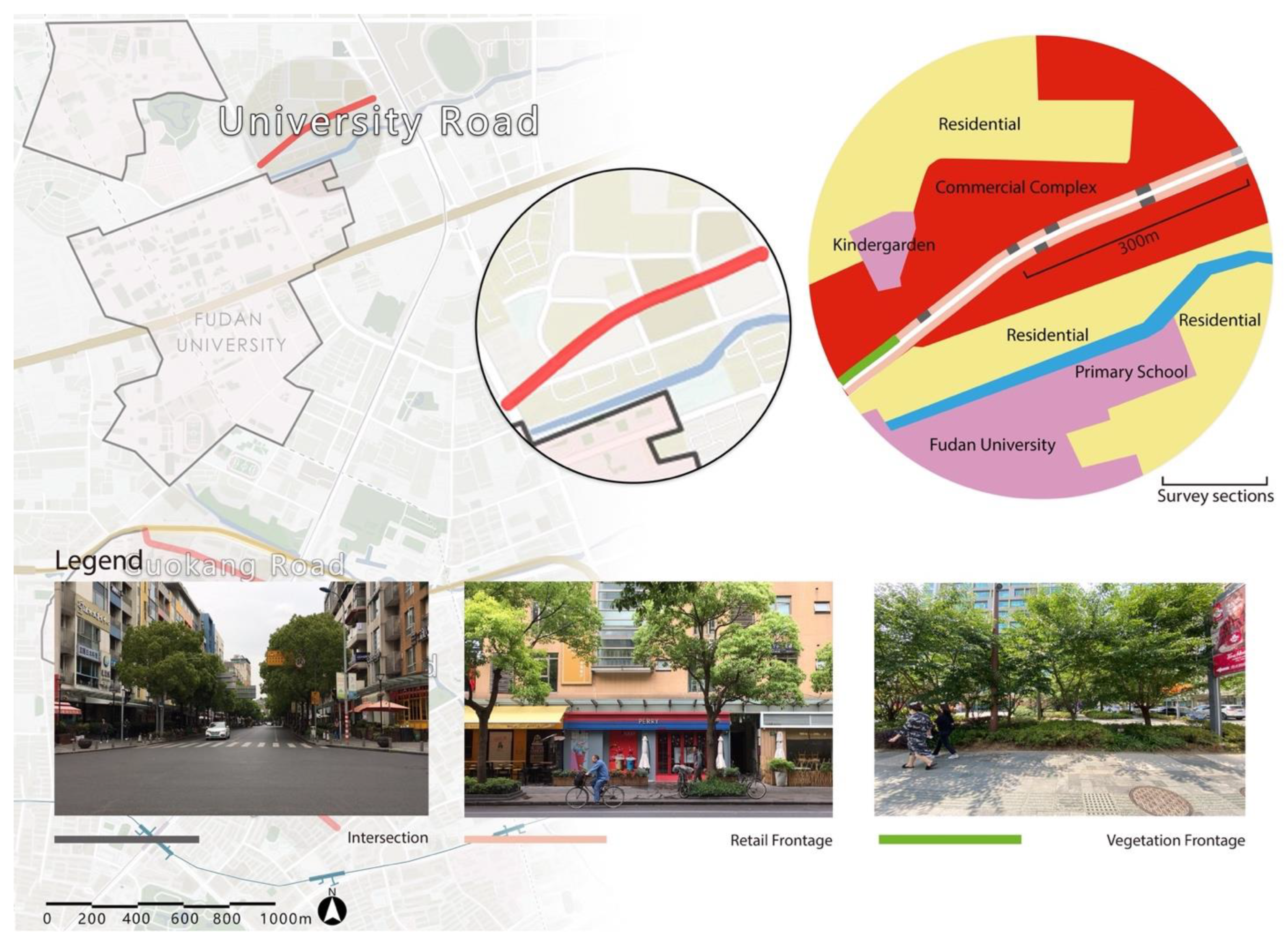
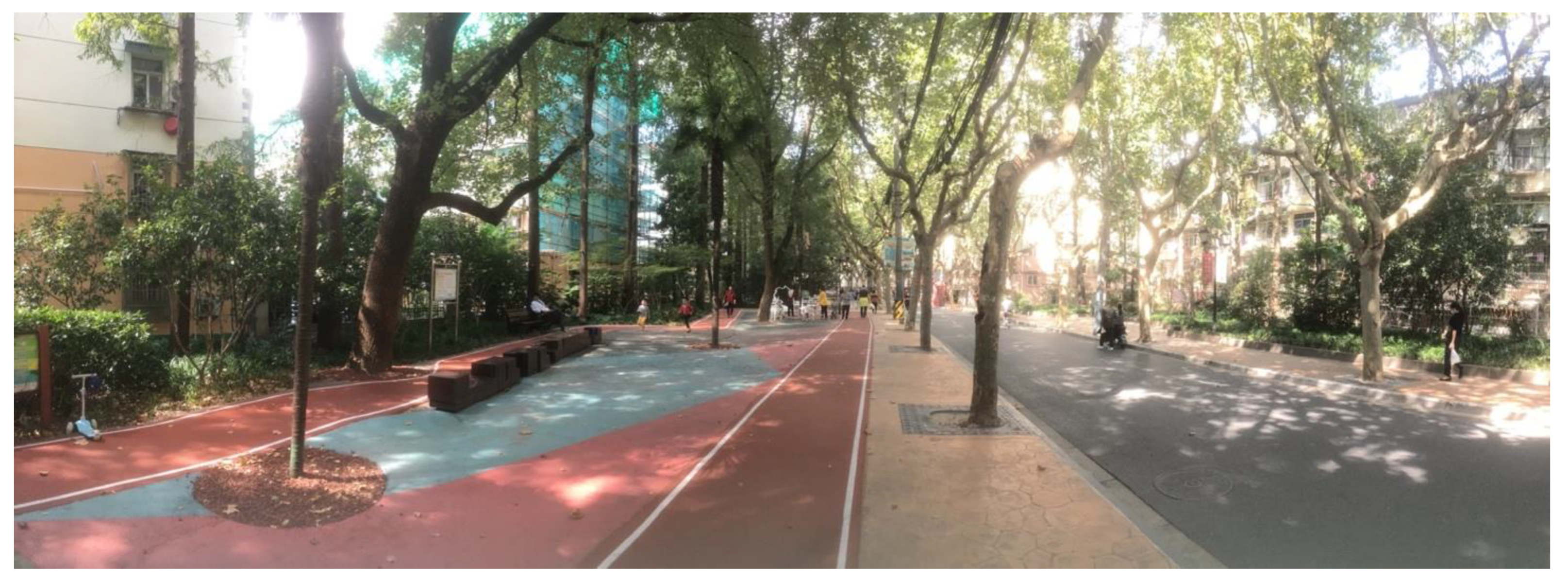
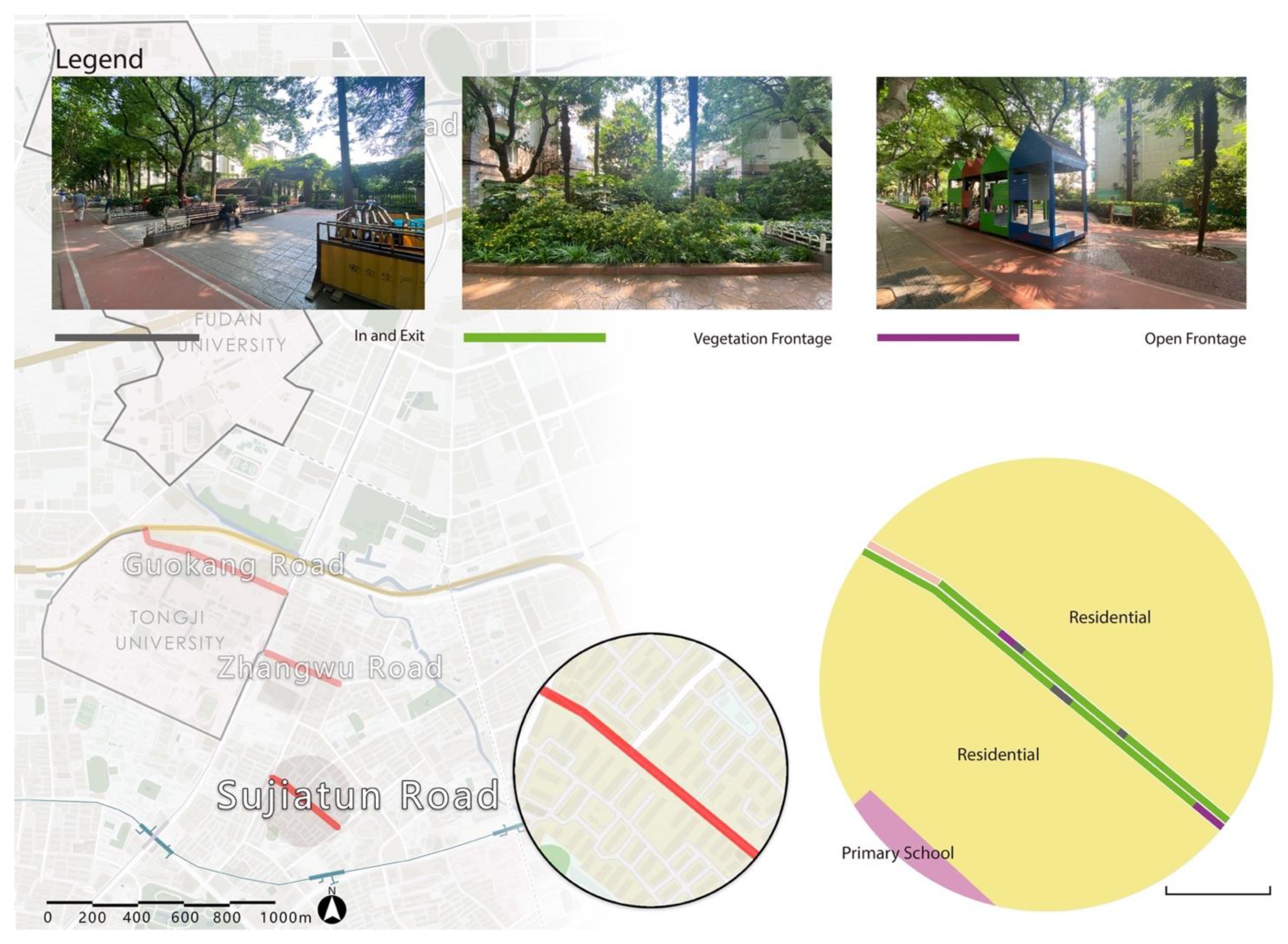
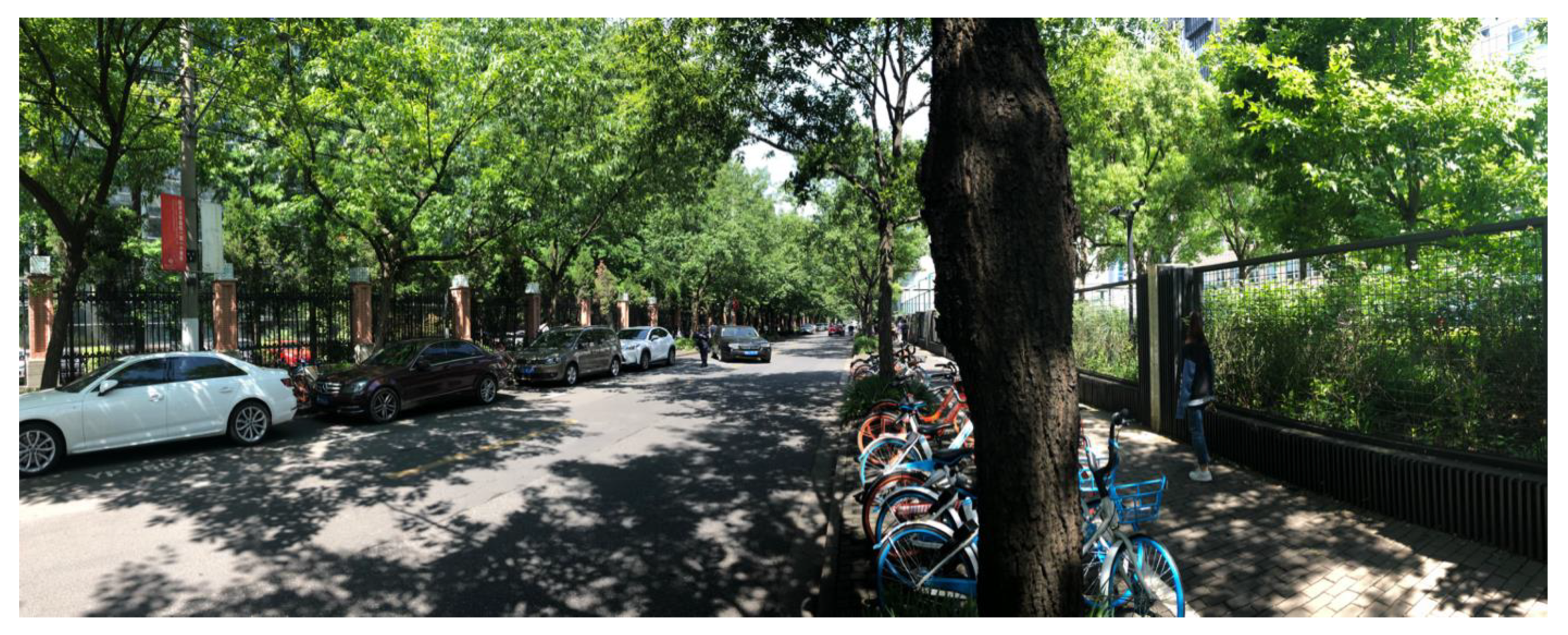
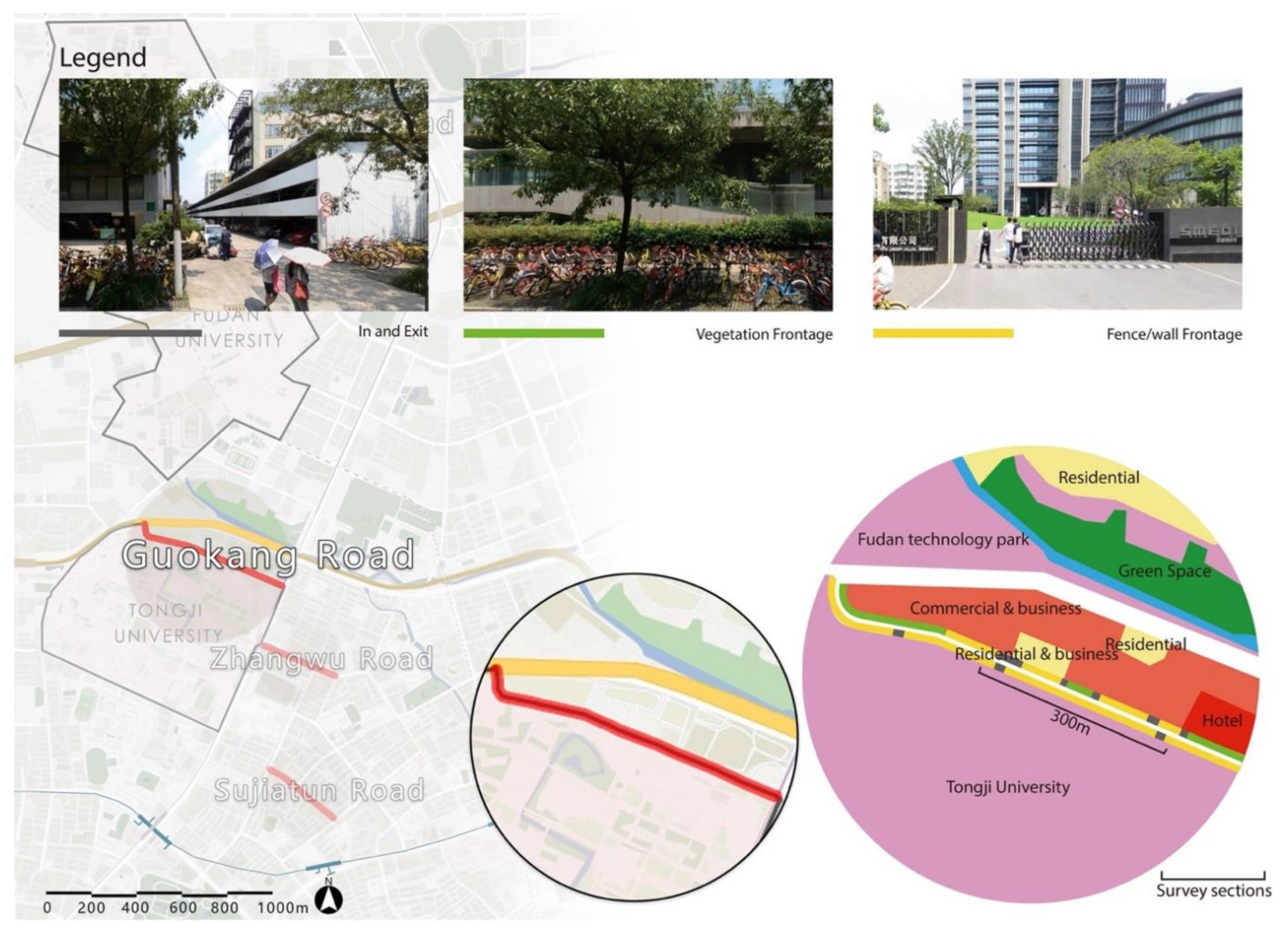
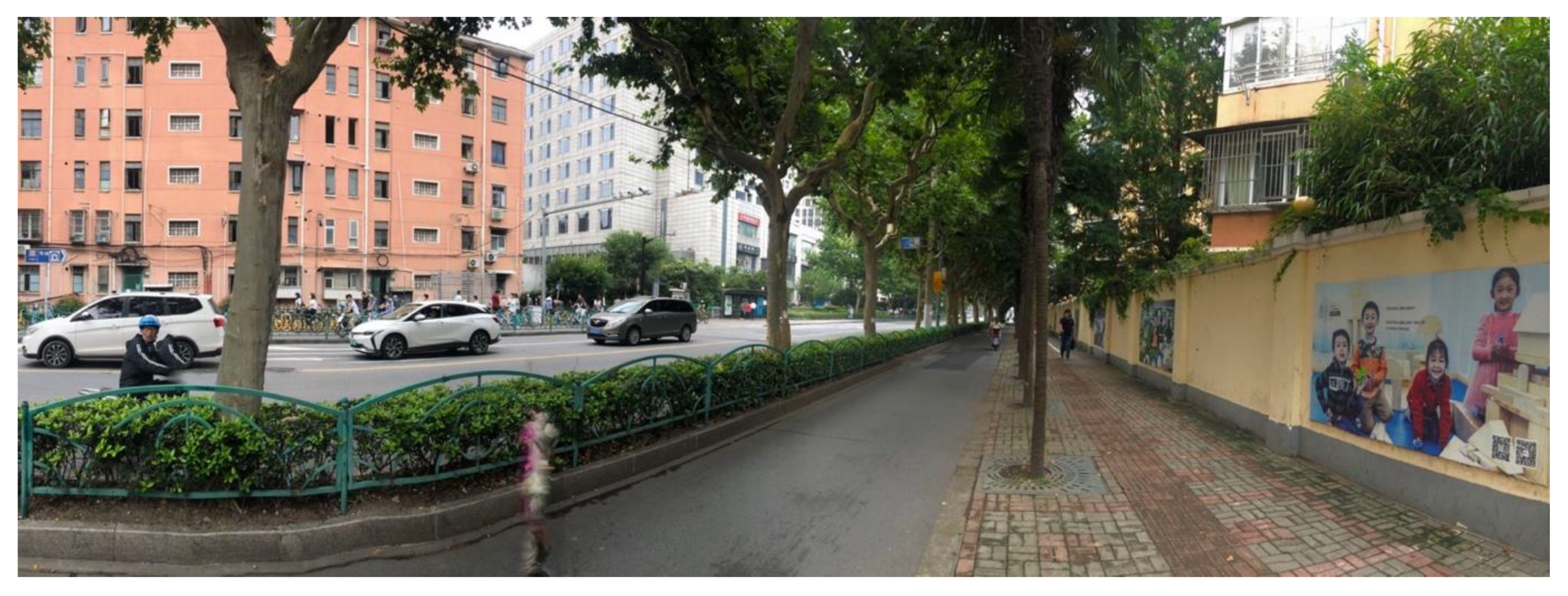
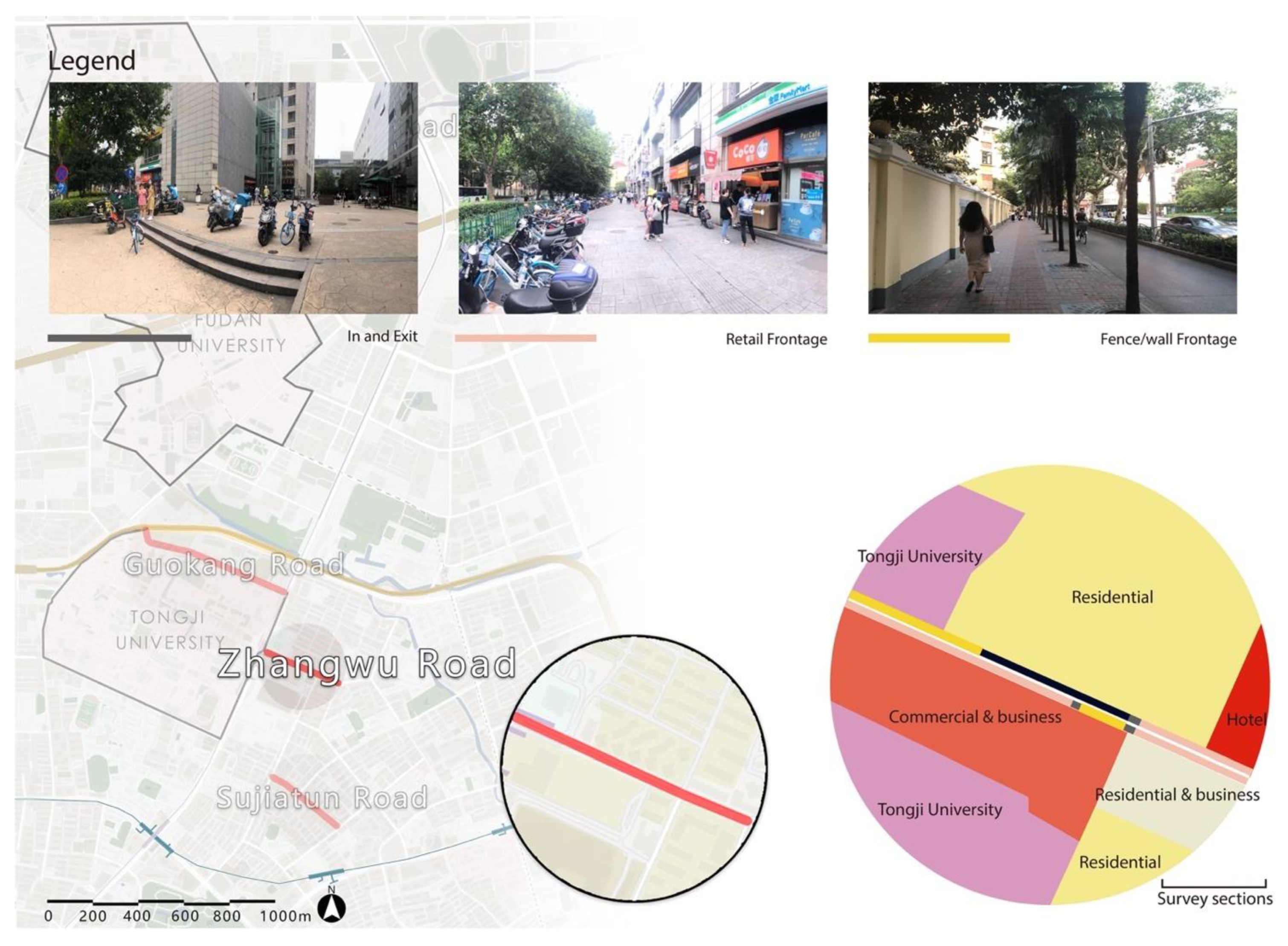
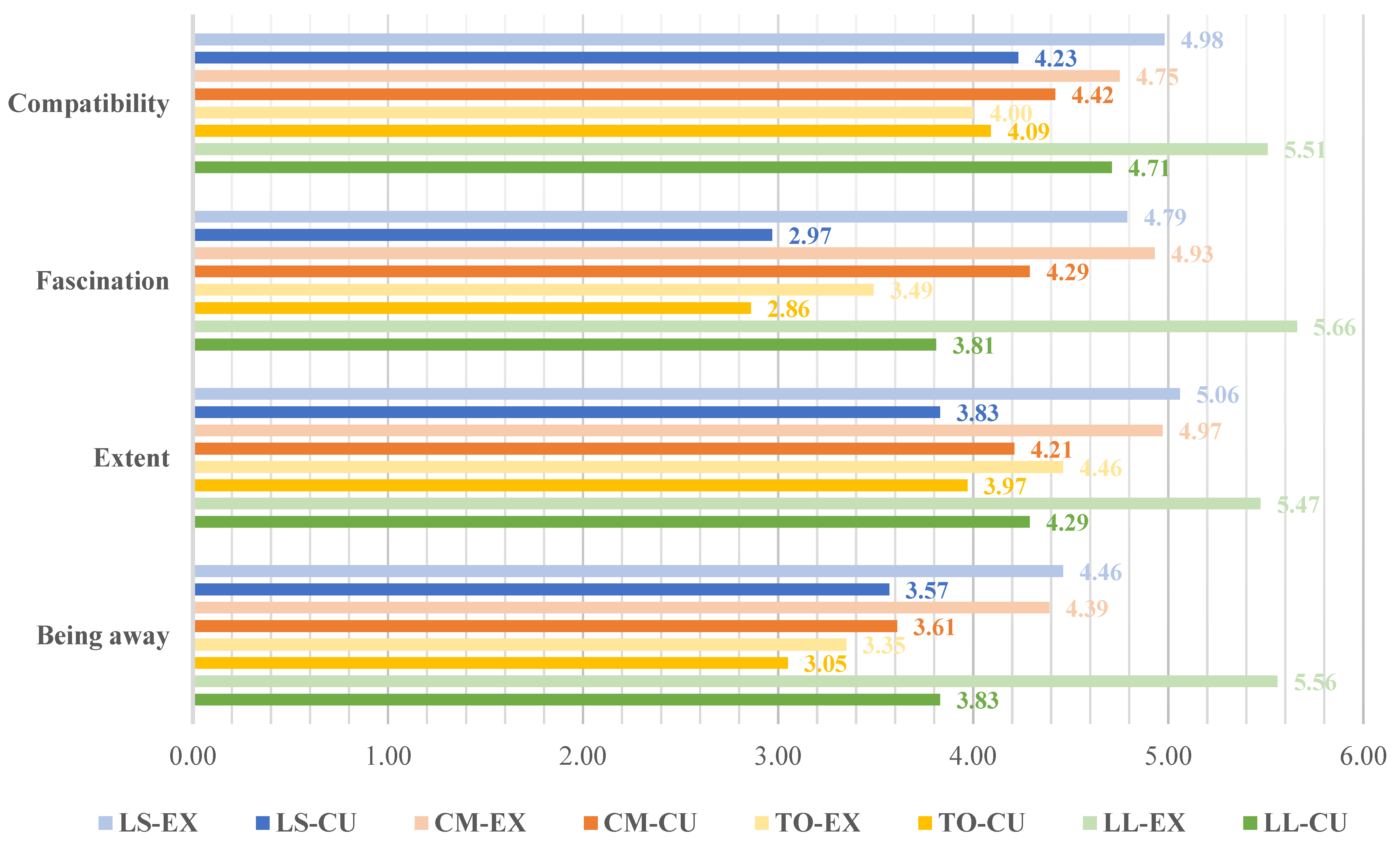
| ART Dimensions | RCS Statement |
|---|---|
| Being Away (B) | B1–When I am here, I feel free from my work and daily routine. B2–When I am here, I feel free from other people’s demands and expectations. B3–When I am here, I do not need to think of my responsibilities and obligations. |
| Extent (E) | E1–The elements here go together. E2–The existing elements belong here. E3–The surroundings are coherent. |
| Fascination (F) | F1–There is plenty to discover here. F2–This setting has many things that I wonder about. F3–There are many objects here that attract my attention. F4–There is plenty that I want to linger on here. F5–I am absorbed in these surroundings. |
| Compatibility (C) | C1–The environment gives me the opportunity to do activities that I like. C2–I can handle the kinds of problems that arise here. C3–I can rapidly adapt to this setting. C4–There is an accordance between what I like to do and this environment. |
| Street Types in Shanghai | Definition and Description |
|---|---|
| Commercial street | This type of street is dominated by retail, food services and other commercial businesses, and has a certain level of service capability and industrial attributes. |
| Living and service street | This type of street is dominated by residential services, small and mid-scale retail, food services and other businesses, as well as public facilities. |
| Landscape andleisure street | This type of street is characterized by waterfront, landscape, or historical characteristics, and equipped with leisure and entertainment facilities. |
| Traffic-oriented street | This type of street is dominated by traffic-volume functionality, with mostly closed frontages. |
| Comprehensive street | This type of street mixes all street types and frontage types, or contains more than two characteristics. |
| Street Type | CM | LL | LS | TO | |||||||||||||
|---|---|---|---|---|---|---|---|---|---|---|---|---|---|---|---|---|---|
| ART Components | B | E | F | C | B | E | F | C | B | E | F | C | B | E | F | C | |
| Expectation Results | Cronbach’s α | 0.85 | 0.91 | 0.90 | 0.84 | 0.85 | 0.90 | 0.92 | 0.88 | 0.84 | 0.89 | 0.91 | 0.86 | 0.92 | 0.88 | 0.96 | 0.87 |
| No. of Participants | 153 | ||||||||||||||||
| Current Results | Cronbach’s α | 0.71 | 0.60 | 0.82 | 0.76 | 0.94 | 0.63 | 0.76 | 0.76 | 0.86 | 0.60 | 0.85 | 0.66 | 0.70 | 0.70 | 0.88 | 0.75 |
| No. of Participants | 30 | 30 | 30 | 31 | |||||||||||||
| LL | B1-LL | B2-LL | B3-LL | E1-LL | E2-LL | E3-LL | F1-LL | F2-LL | F3-LL | F4-LL | F5-LL | C1-LL | C2-LL | C3-LL | C4-LL |
| Mean | 5.71 | 5.67 | 5.29 | 5.39 | 5.56 | 5.48 | 5.50 | 5.44 | 5.67 | 5.88 | 5.79 | 5.53 | 5.48 | 5.54 | 5.48 |
| N | 153 | ||||||||||||||
| Std. Deviation | 1.28 | 1.29 | 1.50 | 1.33 | 1.26 | 1.32 | 1.40 | 1.45 | 1.27 | 1.31 | 1.18 | 1.37 | 1.40 | 1.31 | 1.38 |
| TO | B1-TO | B2-TO | B3-TO | E1-TO | E2-TO | E3-TO | F1-TO | F2-TO | F3-TO | F4-TO | F5-TO | C1-TO | C2-TO | C3-TO | C4-TO |
| Mean | 3.31 | 3.39 | 3.36 | 4.45 | 4.44 | 4.48 | 3.50 | 3.54 | 3.70 | 3.24 | 3.48 | 3.60 | 3.80 | 4.25 | 4.36 |
| N | 153 | ||||||||||||||
| Std. Deviation | 1.78 | 1.82 | 1.75 | 1.65 | 1.66 | 1.63 | 1.75 | 1.72 | 1.82 | 1.86 | 1.83 | 1.72 | 1.78 | 1.71 | 1.78 |
| CM | B1-CM | B2-CM | B3-CM | E1-CM | E2-CM | E3-CM | F1-CM | F2-CM | F3-CM | F4-CM | F5-CM | C1-CM | C2-CM | C3-CM | C4-CM |
| Mean | 4.60 | 4.40 | 4.18 | 5.03 | 4.92 | 4.98 | 5.07 | 5.08 | 5.10 | 4.84 | 4.57 | 4.60 | 4.54 | 4.76 | 5.10 |
| N | 153 | ||||||||||||||
| Std. Deviation | 1.54 | 1.51 | 1.68 | 1.34 | 1.40 | 1.37 | 1.42 | 1.48 | 1.39 | 1.44 | 1.56 | 1.56 | 1.51 | 1.44 | 1.30 |
| LS | B1-LS | B2-LS | B3-LS | E1-LS | E2-LS | E3-LS | F1-LS | F2-LS | F3-LS | F4-LS | F5-LS | C1-LS | C2-LS | C3-LS | C4-LS |
| Mean | 4.66 | 4.58 | 4.16 | 5.05 | 5.13 | 5.01 | 4.86 | 4.81 | 4.92 | 4.80 | 4.56 | 4.66 | 4.94 | 5.10 | 5.23 |
| N | 153 | ||||||||||||||
| Std. Deviation | 1.49 | 1.46 | 1.56 | 1.33 | 1.37 | 1.36 | 1.54 | 1.47 | 1.45 | 1.55 | 1.60 | 1.55 | 1.44 | 1.36 | 1.42 |
| CM | CM-B1 | CM-B2 | CM-B3 | CM-E1 | CM-E2 | CM-E3 | CM-F1 | CM-F2 | CM-F3 | CM-F4 | CM-F5 | CM-C1 | CM-C2 | CM-C3 | CM-C4 |
| Mean | 4.23 | 3.77 | 2.83 | 4.33 | 4.43 | 3.87 | 4.30 | 3.93 | 4.57 | 4.43 | 4.20 | 4.30 | 4.07 | 4.67 | 4.63 |
| N | 30 | 30 | 30 | 30 | 30 | 30 | 30 | 30 | 30 | 30 | 30 | 30 | 30 | 30 | 30 |
| Std. Dev | 1.17 | 1.17 | 1.53 | 1.09 | 0.97 | 1.22 | 1.47 | 1.62 | 1.07 | 1.43 | 1.10 | 1.32 | 1.20 | 0.76 | 0.96 |
| LS | LS-B1 | LS-B2 | LS-B3 | LS-E1 | LS-E2 | LS-E3 | LS-F1 | LS-F2 | LS-F3 | LS-F4 | LS-F5 | LS-C1 | LS-C2 | LS-C3 | LS-C4 |
| Mean | 3.63 | 3.60 | 3.47 | 3.97 | 4.17 | 3.37 | 2.57 | 2.57 | 3.17 | 3.23 | 3.33 | 3.57 | 4.23 | 4.67 | 4.43 |
| N | 30 | 30 | 30 | 30 | 30 | 30 | 30 | 30 | 30 | 30 | 30 | 30 | 30 | 30 | 30 |
| Std. Dev | 1.40 | 1.40 | 1.36 | 1.25 | 1.21 | 1.19 | 1.45 | 1.25 | 1.15 | 1.19 | 1.15 | 1.36 | 1.14 | 0.96 | 1.10 |
| TO | TO-B1 | TO-B2 | TO-B3 | TO-E1 | TO-E2 | TO-E3 | TO-F1 | TO-F2 | TO-F3 | TO-F4 | TO-F5 | TO-C1 | TO-C2 | TO-C3 | TO-C4 |
| Mean | 3.23 | 3.16 | 2.77 | 4.42 | 4.06 | 3.42 | 2.65 | 2.58 | 3.06 | 2.74 | 3.26 | 3.52 | 4.10 | 4.84 | 3.90 |
| N | 31 | 31 | 31 | 31 | 31 | 31 | 31 | 31 | 31 | 31 | 31 | 31 | 31 | 31 | 31 |
| Std. Dev | 1.41 | 1.39 | 1.38 | 1.15 | 1.09 | 1.46 | 1.92 | 1.63 | 1.39 | 1.81 | 1.59 | 1.55 | 1.33 | 0.97 | 1.35 |
| LL | LL-B1 | LL-B2 | LL-B3 | LL-E1 | LL-E2 | LL-E3 | LL-F1 | LL-F2 | LL-F3 | LL-F4 | LL-F5 | LL-C1 | LL-C2 | LL-C3 | LL-C4 |
| Mean | 4.40 | 3.83 | 3.27 | 4.47 | 4.63 | 3.77 | 3.30 | 3.10 | 4.17 | 4.50 | 3.97 | 4.77 | 4.37 | 5.17 | 4.53 |
| N | 30 | 30 | 30 | 30 | 30 | 30 | 30 | 30 | 30 | 30 | 30 | 30 | 30 | 30 | 30 |
| Std. Dev | 1.13 | 1.37 | 1.31 | 0.82 | 1.03 | 1.79 | 1.51 | 1.58 | 1.21 | 1.48 | 1.56 | 0.94 | 1.03 | 0.75 | 1.28 |
| Being Away | Extent | Fascination | Compatibility | |||||||||||||
|---|---|---|---|---|---|---|---|---|---|---|---|---|---|---|---|---|
| B1 | B2 | B3 | E1 | E2 | E3 | F1 | F2 | F3 | F4 | F5 | C1 | C2 | C3 | C4 | ||
| Professional groups | CM Street | 0.62 | 0.16 | 0.34 | 0.67 | 0.88 | 0.93 | 0.91 | 0.36 | 0.49 | 0.30 | 0.45 | 0.72 | 0.56 | 0.62 | 0.54 |
| LS Street | 0.11 | 0.04 | 0.27 | 0.30 | 0.50 | 0.61 | 0.81 | 0.50 | 0.77 | 0.58 | 0.82 | 0.46 | 0.33 | 0.92 | 0.94 | |
| LL Street | 0.04 | 0.12 | 0.05 | 0.17 | 0.20 | 0.02 | 0.03 | 0.03 | 0.01 | 0.24 | 0.09 | 0.08 | 0.13 | 0.25 | 0.00 | |
| TO Street | 0.00 | 0.00 | 0.00 | 0.02 | 0.01 | 0.01 | 0.00 | 0.01 | 0.00 | 0.00 | 0.25 | 0.14 | 0.51 | 0.20 | 0.01 | |
| Gender groups | CM Street | 0.42 | 0.62 | 0.09 | 0.82 | 0.36 | 0.76 | 0.09 | 0.21 | 0.06 | 0.04 | 0.73 | 0.01 | 0.05 | 0.38 | 0.00 |
| LS Street | 0.58 | 0.75 | 0.18 | 0.02 | 0.23 | 0.17 | 0.17 | 0.02 | 0.10 | 0.19 | 0.45 | 0.05 | 0.23 | 0.16 | 0.05 | |
| LL Street | 0.50 | 0.73 | 0.16 | 0.96 | 0.75 | 0.80 | 0.40 | 0.62 | 0.92 | 0.31 | 0.91 | 0.78 | 0.76 | 0.33 | 0.31 | |
| TO Street | 0.52 | 0.25 | 0.21 | 0.07 | 0.24 | 0.44 | 0.98 | 0.61 | 0.95 | 0.98 | 0.94 | 0.87 | 0.15 | 0.36 | 0.19 | |
| Age groups | CM Street | 0.53 | 0.05 | 0.16 | 0.91 | 0.69 | 0.67 | 0.94 | 0.95 | 0.51 | 0.17 | 0.04 | 0.59 | 0.22 | 0.46 | 0.50 |
| LS Street | 0.05 | 0.04 | 0.02 | 0.40 | 0.95 | 0.43 | 0.42 | 0.86 | 0.33 | 0.32 | 0.09 | 0.20 | 0.94 | 0.76 | 0.38 | |
| LL Street | 0.14 | 0.19 | 0.16 | 0.31 | 0.51 | 0.35 | 0.43 | 0.76 | 0.44 | 0.31 | 0.32 | 0.29 | 0.22 | 0.11 | 0.59 | |
| TO Street | 0.01 | 0.11 | 0.14 | 0.13 | 0.44 | 0.28 | 0.00 | 0.03 | 0.00 | 0.00 | 0.00 | 0.03 | 0.03 | 0.23 | 0.39 | |
| Being Away | Extent | Fascination | Compatibility | |||||||||||||
|---|---|---|---|---|---|---|---|---|---|---|---|---|---|---|---|---|
| B1 | B2 | B3 | E1 | E2 | E3 | F1 | F2 | F3 | F4 | F5 | C1 | C2 | C3 | C4 | ||
| Professional groups | University Road | 0.33 | 0.01 | 0.41 | 0.60 | 0.83 | 0.90 | 0.90 | 0.88 | 0.48 | 0.17 | 0.21 | 0.88 | 0.96 | 0.65 | 0.60 |
| Zhangwu Road | 0.18 | 0.71 | 0.42 | 0.11 | 0.25 | 0.35 | 0.94 | 0.80 | 0.17 | 0.51 | 0.72 | 0.50 | 0.77 | 0.94 | 0.33 | |
| Sujiatun Road | 0.91 | 0.53 | 0.92 | 0.79 | 0.77 | 0.93 | 0.96 | 0.75 | 0.31 | 0.95 | 0.97 | 0.15 | 0.38 | 0.43 | 0.21 | |
| Guokang Road | 0.50 | 0.40 | 0.01 | 0.27 | 0.42 | 0.21 | 0.90 | 0.26 | 0.52 | 0.26 | 0.14 | 0.30 | 0.35 | 0.11 | 0.30 | |
| Gender groups | University Road | 0.33 | 0.01 | 0.41 | 0.60 | 0.83 | 0.90 | 0.90 | 0.88 | 0.48 | 0.17 | 0.21 | 0.88 | 0.99 | 0.65 | 0.60 |
| Zhangwu Road | 0.05 | 0.41 | 0.19 | 0.22 | 0.12 | 0.61 | 0.59 | 0.37 | 0.90 | 0.39 | 0.85 | 0.09 | 0.09 | 0.46 | 0.42 | |
| Sujiatun Road | 0.84 | 0.23 | 0.27 | 0.52 | 0.10 | 0.22 | 0.13 | 0.58 | 0.35 | 0.02 | 0.08 | 0.02 | 0.36 | 0.60 | 0.92 | |
| Guokang Road | 0.92 | 0.98 | 0.01 | 0.52 | 0.18 | 0.29 | 0.55 | 0.09 | 0.09 | 0.35 | 0.16 | 0.20 | 0.23 | 0.10 | 0.23 | |
| Age groups | University Road | 0.23 | 0.07 | 0.18 | 0.65 | 0.49 | 0.23 | 0.22 | 0.59 | 0.23 | 0.78 | 0.88 | 0.67 | 0.09 | 0.89 | 0.33 |
| Zhangwu Road | 0.29 | 0.29 | 0.57 | 0.72 | 0.41 | 0.97 | 0.78 | 0.11 | 0.24 | 0.01 | 0.66 | 0.32 | 0.59 | 0.39 | 0.94 | |
| Sujiatun Road | 0.09 | 0.41 | 0.66 | 0.97 | 0.76 | 0.12 | 0.08 | 0.55 | 0.19 | 0.10 | 0.29 | 0.31 | 0.71 | 0.65 | 0.47 | |
| Guokang Road | 0.31 | 0.97 | 0.18 | 0.35 | 0.33 | 0.76 | 0.53 | 0.09 | 0.15 | 0.43 | 0.02 | 0.01 | 0.85 | 0.23 | 0.67 | |
| Street Type | Restorativeness | Being Away | Extent | Fascination | Compatibility |
|---|---|---|---|---|---|
| Landscape and Leisure Street (Sujiatun Road) | Current restorativeness (N = 30) | 3.83 | 4.29 | 3.81 | 4.71 |
| Std. Dev | 1.13 | 0.96 | 1.17 | 0.72 | |
| Expected restorativeness (N = 153) | 5.56 | 5.47 | 5.66 | 5.51 | |
| Std. Dev | 1.20 | 1.19 | 1.16 | 1.18 | |
| Sig. | 0.48 | 0.10 | 0.65 | 0.00 | |
| Traffic-oriented Street (Guokang Road) | Current restorativeness (N = 31) | 3.05 | 3.97 | 2.86 | 4.09 |
| Std. Dev | 1.10 | 0.98 | 1.38 | 0.99 | |
| Expected restorativeness (N = 153) | 3.35 | 4.46 | 3.49 | 4.00 | |
| Std. Dev | 1.66 | 1.48 | 1.66 | 1.48 | |
| Sig. | 0.00 | 0.01 | 0.19 | 0.08 | |
| Commercial Street (University Road) | Current restorativeness (N = 30) | 3.61 | 4.21 | 4.29 | 4.42 |
| Std. Dev | 1.04 | 0.80 | 1.03 | 0.83 | |
| Expected restorativeness (N = 153) | 4.39 | 4.97 | 4.93 | 4.75 | |
| Std. Dev | 1.39 | 1.26 | 1.23 | 1.20 | |
| Sig. | 0.06 | 0.01 | 0.17 | 0.02 | |
| Living and Service Street (Zhangwu Road) | Current restorativeness (N = 30) | 3.57 | 3.83 | 2.97 | 4.23 |
| Std. Dev | 1.31 | 0.92 | 0.89 | 0.87 | |
| Expected restorativeness (N = 153) | 4.46 | 5.06 | 4.79 | 4.98 | |
| Std. Dev | 1.31 | 1.23 | 1.31 | 1.21 | |
| Sig. | 0.64 | 0.12 | 0.01 | 0.10 |
Publisher’s Note: MDPI stays neutral with regard to jurisdictional claims in published maps and institutional affiliations. |
© 2022 by the authors. Licensee MDPI, Basel, Switzerland. This article is an open access article distributed under the terms and conditions of the Creative Commons Attribution (CC BY) license (https://creativecommons.org/licenses/by/4.0/).
Share and Cite
Yin, Y.; Thwaites, K.; Shao, Y. Balancing Street Functionality and Restorative Benefit: Developing an Expectation–Current Approach to Street Design. Sustainability 2022, 14, 5736. https://doi.org/10.3390/su14095736
Yin Y, Thwaites K, Shao Y. Balancing Street Functionality and Restorative Benefit: Developing an Expectation–Current Approach to Street Design. Sustainability. 2022; 14(9):5736. https://doi.org/10.3390/su14095736
Chicago/Turabian StyleYin, Yuting, Kevin Thwaites, and Yuhan Shao. 2022. "Balancing Street Functionality and Restorative Benefit: Developing an Expectation–Current Approach to Street Design" Sustainability 14, no. 9: 5736. https://doi.org/10.3390/su14095736
APA StyleYin, Y., Thwaites, K., & Shao, Y. (2022). Balancing Street Functionality and Restorative Benefit: Developing an Expectation–Current Approach to Street Design. Sustainability, 14(9), 5736. https://doi.org/10.3390/su14095736







